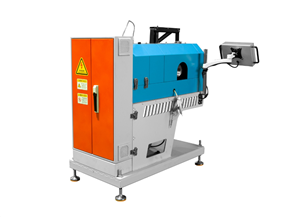Pomen talilnih filtrov za recikliranje plastike v sektorju recikliranja
Plastic recycling melt filters serve as core equipment in the production of recycled plastics, functioning to remove impurities from molten plastic and ensure the quality and performance of recycled materials. The following analysis details their significance in the recycling sector from the dimensions of technical principles, application value, and industry impact:
I. Core Functions of Melt Filters: Precise Impurity Removal
1. Filtration Objects and Technical Principles
Types of Impurities
Physical impurities: dust, metal debris, sand, uncrushed foreign objects (such as residual label paper);
Chemical impurities: oxidation degradation products, residual additives (e.g., plasticizers, flame retardants), and mixed melts of different plastics (e.g., PE mixed in PP).
Filtration Principle:
Solid particles in the melt are intercepted by porous media (such as metal screens or sintered filter elements). Pure melt is pushed through by pressure difference, while impurities are retained. For example, a 60-mesh screen can filter particles above ~250 microns, and a 100-mesh screen can filter down to below 150 microns (higher mesh number = higher filtration accuracy).
2. Direct Impact on the Quality of Recycled Materials
Enhanced Mechanical Properties:
Removing impurities avoids dddhhhweak pointsdddhhh in recycled materials. For instance, if metal debris remains in recycled PET, the fiber breaking strength will decrease by over 30%;
Improved Appearance:
The transparency and color uniformity of recycled materials are significantly improved after filtration. When recycled PP is used for transparent containers, high-mesh filters (e.g., 120-mesh) are required to remove micron-level impurities;
Melting Stability:
Impurities cause fluctuations in melt viscosity. After filtration, the pressure fluctuation range during extrusion can be reduced from ±10% to within ±3%, improving the dimensional accuracy of products.
II. Key Roles of Melt Filters in the Entire Recycling Process
1. Protecting Downstream Equipment and Reducing Maintenance Costs
Protection of Extruder Screws and Molds:
If impurities are not filtered, metal particles will scratch the screw threads, shortening their service life (normal lifespan: 5-8 years; impurity wear can reduce it to 2-3 years). If mold runners are blocked by impurities, frequent shutdowns for cleaning are required, affecting production efficiency (each shutdown incurs losses of approximately $500-$2,000).
Case Study:
A PET bottle chip recycling plant that did not use an efficient filter replaced its extruder screw 3 times within six months, increasing maintenance costs by ¥200,000. After switching to a candle-type filter, the screw lifespan extended to 4 years, saving ¥150,000 annually.
2. Expanding Application Scenarios of Recycled Materials
| Filtration Accuracy | Typical Application Fields | Impurity Residue Requirements |
|---|---|---|
| 40-60 mesh | Low-end products (trash bins, pallets) | Impurity content < 0.5% |
| 80-120 mesh | Home appliance casings, automotive interior parts | Impurity content < 0.2% |
| 150-200 mesh | Food-contact packaging (such as recycled PET bottles) | Impurity content < 0.05%, and odorless |
Example:
Food-grade recycled PET materials need to pass through a melt filter with a mesh number of more than 200, combined with activated carbon adsorption, to meet the impurity and odor requirements of the FDA (U.S. Food and Drug Administration) for dddhhhfood-contact plasticsdddhhh.
3. Enhancing the Economic Value of Recycled Materials
Price Difference:
The price of unfiltered recycled PP materials is about 4,000 yuan/ton, while that of filtered materials can reach 6,000-8,000 yuan/ton (depending on the accuracy); the price of recycled materials used in high-end fields (such as medical device components) can exceed 12,000 yuan/ton.
Cost-Benefit Balance:
An automatic screen changer melt filter costs about 50,000-200,000 yuan, but it can increase the premium of recycled materials by 20%-50%, and the equipment investment is usually recovered within 6-12 months.
III. Technical Advantages and Applicable Scenarios of Different Types of Melt Filters
1. Screen Plate Filters (such as the screen plates used in the TL650 series)
Features: Simple structure, filtering is achieved by replacing metal screen plates, and the cost is low;
Applicable Scenarios: (Production capacity of 500-4,000 kg/h) and waste materials with high impurity content (such as agricultural films and construction waste plastics);
Advantages: No need for manual regular screen changing (replace once every about 20-30 days), and with disassembly tools, it greatly reduces costs and improves efficiency for customers.
2. Candle Filters
Features: Adopt porous sintered filter elements (such as stainless steel powder sintering), with a large filtration area and high accuracy (up to 10 microns);
Applicable Scenarios: High-purity recycling scenarios such as PET bottle chips and medical plastics;
Advantages: Online backwashing is possible, reducing downtime and suitable for continuous production.
3. Automatic Screen Changer Filters
Features: Screen plates are replaced by hydraulic drive without shutdown, and the filtration accuracy is adjustable from 10 to 100 microns;
Applicable Scenarios: Large-scale production (production capacity ssshhh 1 ton/h), such as PE film recycling and granulation lines;
IV. Industry Trends: Technological Upgrades of Filters Driving Innovation in the Recycling Industry
1. Combination of High Precision and Intelligence
Development Trends:
Introduce AI visual monitoring systems to detect the impurity content in the melt in real time and automatically adjust the filtration pressure;
Develop dddhhhgradient filtrationdddhhh technology, with the first layer for coarse filtration (40 mesh) to remove large particles and the second layer for fine filtration (200 mesh) to remove micron-level impurities, improving efficiency.
2. Environmental Protection and Energy-Saving Design
Low-Energy Filters:
Combine electric heating with thermal insulation layers to reduce heat loss during the melting process (traditional filters consume about 0.3 kWh/kg, and new energy-saving types can be reduced to 0.15 kWh/kg);
Waste Recycling:
If the intercepted impurities contain recyclable plastics, the waste recycling rate can be increased from 60% to more than 90% through crushing and secondary filtration technologies.
3. International Standards Driving Technological Upgrades
Requirements of the EU's New Plastic Strategy:
By 2030, all plastic packaging must be 100% recyclable, and the impurity content in recycled materials must be < 0.1%, promoting the development of melt filters towards dddhhhhigh precision + automationdddhhh;
Provisions of China's dddhhhStandards for the Comprehensive Utilization of Waste Plasticsdddhhh:
When recycled PET materials are used for food packaging, they must pass through a filter with a mesh number of more than 150 and provide a third-party test report.
V. Conclusion: Melt Filters as the dddhhhQuality Gatekeepersdddhhh of the Recycling Industry Chain
In the field of plastic recycling, melt filters are not only tools for removing impurities but also key nodes connecting dddhhhwastedddhhh and dddhhhhigh-value recycled materialsdddhhh. Their importance can be summarized as follows:
Technical Aspect: Determine whether recycled materials can enter high-end application fields (such as food packaging and medical devices);
Economic Aspect: Break the vicious circle of dddhhhlow quality and low pricedddhhh for recycling enterprises by improving material quality;
Environmental Aspect: Help achieve a dddhhhplastic circular economydddhhh and reduce the downgraded use or secondary pollution of recycled materials caused by impurities.
Therefore, choosing a suitable melt filter (such as selecting the mesh number of the screen plate according to the type of waste and the automatic screen changing system according to the production capacity) is one of the core strategies for recycling enterprises to enhance their competitiveness.




